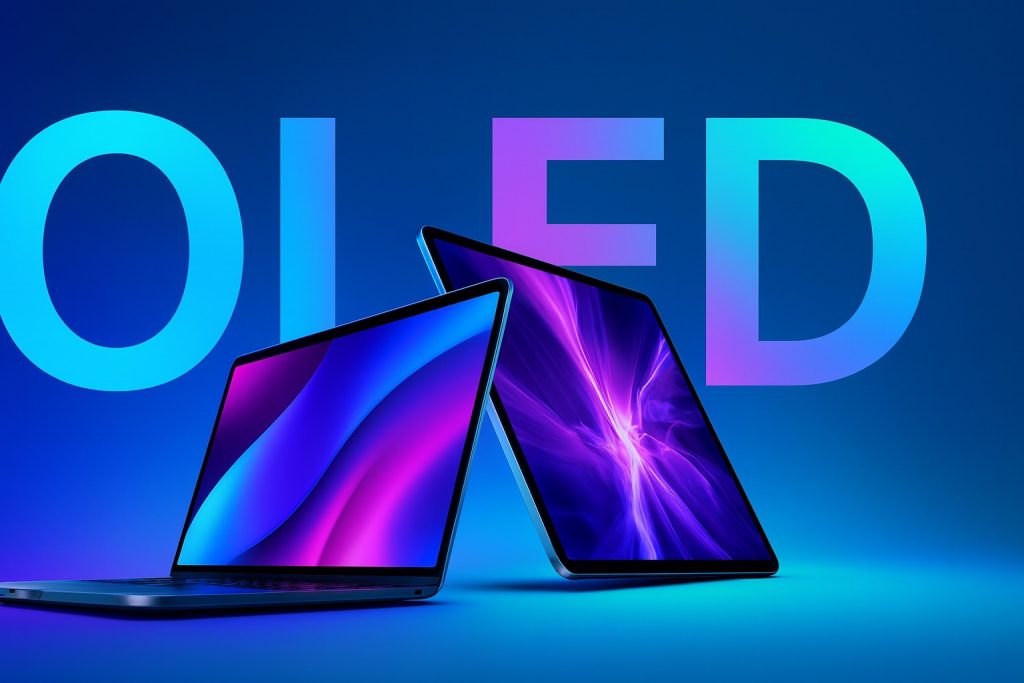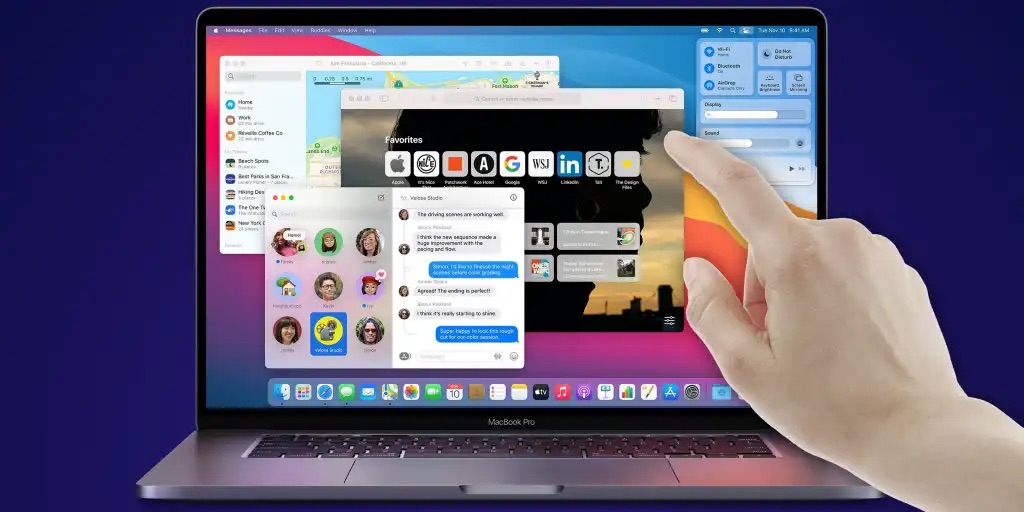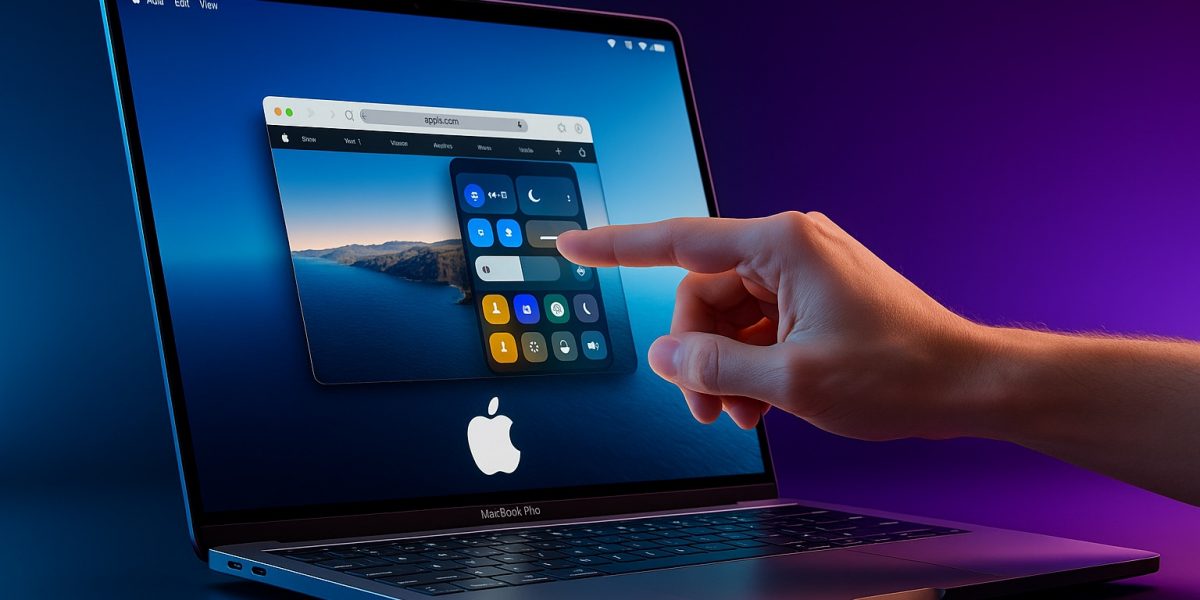Apple is developing its first Mac computer with touchscreen capability, representing a fundamental departure from the company’s longstanding opposition to touch-enabled laptops. The tech giant is preparing a completely redesigned MacBook Pro featuring an OLED display with touch functionality, expected to launch between late 2026 and early 2027, according to reporting from Bloomberg’s Mark Gurman.
The revolutionary laptops, carrying internal codenames K114 and K116, will be powered by next-generation M6 processors and feature significantly thinner and lighter construction compared to current models. This ambitious redesign arrives just days after Apple released its first M5-based MacBook Pro on October 14, 2025.
Reversing Decades of Design Philosophy
This move represents a seismic shift in Apple’s design thinking, overturning a position dating back to co-founder Steve Jobs, who famously stated that “touch surfaces don’t want to be vertical.” The new MacBook Pro models will incorporate OLED display technology—the same standard currently used in iPhone and iPad Pro—marking the first implementation of this advanced display system in a Mac product.
Despite adding touchscreen capabilities, Apple plans to retain the traditional trackpad and keyboard, positioning touch functionality as a supplementary input method rather than a replacement. Bloomberg reports that Apple has solved a critical engineering challenge by developing “reinforced hinge and screen hardware to prevent the display from bouncing or moving when touched.”
Understanding the Engineering Challenge
Creating a touchscreen laptop that feels natural requires solving problems that don’t exist in tablets or phones. When you touch a vertical screen, physics works against you—the pressure pushes the display backward, creating instability and an uncomfortable user experience. This mechanical challenge represents one reason Apple resisted touchscreen laptops for so long.
The reinforced hinge solution Apple developed addresses this fundamental issue. By strengthening the connection between the display and the base, Apple can maintain screen stability during touch interaction without requiring users to grip the display edges or apply awkward pressure. This engineering refinement makes the difference between a gimmick and genuinely useful functionality.

OLED Technology Comes to Mac
OLED displays offer several advantages over the current mini-LED technology in MacBook Pro models. Each pixel emits its own light, enabling true blacks by completely turning off pixels rather than dimming a backlight. This creates infinite contrast ratios, more vibrant colors, and improved power efficiency when displaying darker content.
For creative professionals working with photo and video editing, OLED’s color accuracy and contrast capabilities enhance their ability to see subtle gradations in shadows and highlights. For general users, it simply means more vivid content with deeper blacks and punchier colors across everything from movies to spreadsheets.
The transition to OLED also typically enables thinner displays since OLED panels don’t require the backlight layers needed for LCD and mini-LED screens. This contributes to Apple’s goal of making these redesigned MacBook Pro models significantly thinner and lighter.
M6 Processor Expectations
While Apple hasn’t disclosed M6 specifications, the processor will likely follow the architectural evolution established with M5. Expect continued improvements in Neural Engine performance for AI workloads, GPU enhancements for graphics and machine learning, and incremental CPU performance gains.
The timing—roughly 18 months after M5’s October 2025 launch—aligns with Apple’s silicon development cadence. By late 2026 or early 2027, manufacturing process improvements and architectural refinements should enable meaningful performance-per-watt improvements over M5 while maintaining or improving battery life despite the thinner chassis.
Design Implications and Form Factor Changes
“Significantly thinner and lighter” suggests Apple is pursuing a major industrial design refresh rather than incremental refinement. Current 14-inch and 16-inch MacBook Pro models prioritize performance and battery life over ultimate portability. A redesign focusing on reduced thickness and weight indicates Apple may be rebalancing these priorities.
This doesn’t necessarily mean compromised performance. Apple’s silicon efficiency improvements generation-over-generation create headroom to reduce chassis volume while maintaining or improving capabilities. The M-series chips already generate less heat than Intel processors previously used in MacBook Pro models, enabling more compact cooling solutions.
The thinner profile combined with OLED technology could also enable new display aspect ratios or reduced bezels, maximizing screen real estate within a smaller overall footprint.
How Touchscreen Changes Mac Workflows
Adding touch to MacBook Pro creates new interaction possibilities while potentially introducing challenges. Some scenarios where touch makes immediate sense:
Photo and video editing: Direct manipulation of timeline elements, pinch-to-zoom on images, and quick adjustments feel more natural with touch than mouse/trackpad for certain operations.
Annotation and markup: Drawing on screenshots, marking up PDFs, or sketching ideas becomes more intuitive with direct screen contact.
Scrolling and navigation: Quick swipes through long documents or web pages can feel faster than trackpad scrolling.
Casual consumption: When leaning back watching content, reaching up to tap the screen may feel more convenient than reaching down to the trackpad.
However, challenges exist:
Ergonomic fatigue: Extended vertical touchscreen use causes arm fatigue—the “gorilla arm” problem that originally informed Apple’s no-touch-Mac policy.
Fingerprints and smudges: OLED displays show fingerprints prominently. Users will need to clean screens more frequently.
Accidental touches: Depending on sensitivity calibration, unintentional screen contact could cause frustration.
Workflow interruption: Switching between keyboard/trackpad and touch requires hand repositioning that may slow rather than accelerate certain tasks.
Apple’s decision to retain traditional input methods suggests they understand these tradeoffs. Touch serves as an option for tasks where it provides genuine advantages, not a forced replacement of proven interaction methods.
Market Context and Competitive Positioning
Windows laptops have offered touchscreens for over a decade, with varying success. Some users love the option; others rarely touch the display. Apple’s late entry allows them to observe which touchscreen implementations succeeded, which failed, and why.
Microsoft’s Surface line demonstrates that well-executed touchscreen laptops can appeal to creative professionals and general users alike, particularly when combined with stylus support. While Apple hasn’t announced Apple Pencil compatibility for these MacBook Pro models, the OLED touchscreen would enable it technically.
Competitors like Dell, HP, and Lenovo have refined touchscreen laptop designs considerably since early implementations. Apple benefits from this collective industry learning while bringing its own design sensibility and engineering approach.
Software Adaptation Requirements
macOS will need thoughtful updates to support touch interaction effectively. Simply making existing interface elements finger-sized risks compromising the precision and information density that makes desktop operating systems powerful.
Apple’s experience adapting iPadOS—which shares foundational code with macOS—provides relevant learnings. The challenge involves creating touch-friendly interfaces that coexist with traditional mouse/trackpad interaction without forcing users to choose between them or learn entirely different interaction paradigms.
Developers will need to consider touch input when designing Mac applications, potentially creating new opportunities for innovative interaction designs that leverage touch where it makes sense while preserving keyboard/mouse efficiency where that remains superior.
Timeline Considerations and Market Introduction
The late 2026 to early 2027 launch window positions these redesigned MacBook Pro models roughly two years after the M5 introduction in October 2025. This timing aligns with Apple’s typical major redesign cycles, which occur every 3-4 years for Mac products.
The substantial changes—touchscreen, OLED, M6 processor, thinner/lighter design—justify the longer development timeline. Apple rarely introduces multiple major changes simultaneously unless they’re confident in the execution and have thoroughly validated the design through internal testing and development units.
Pre-orders for current M5 MacBook Pro models likely won’t be significantly impacted by this announcement since the redesigned versions remain over a year away. However, potential buyers considering purchases in mid-to-late 2026 may choose to wait for the new design.
Evaluating Whether to Wait
For users considering MacBook Pro purchases, several factors influence the wait-or-buy decision:
Current M5 MacBook Pro owners: Unless you specifically need touchscreen functionality, the M5 models deliver excellent performance. The redesigned versions offer meaningful changes but likely won’t obsolete M5 capabilities for typical professional workflows.
Older MacBook Pro users (2020-2022 models): If your current system meets your needs, waiting for the redesigned models makes sense. You’ll get multiple significant upgrades—touchscreen, OLED, M6 performance, thinner design—rather than a single-generation improvement.
Windows laptop users considering Mac: The redesigned models remove a feature disparity (touchscreen) that may have prevented you from considering Mac previously. Waiting could make sense if touchscreen capability matters to your workflow.
Users needing immediate upgrades: If your current system is failing or significantly impeding productivity, buying now makes more sense than waiting 12-18 months. The M5 MacBook Pro already represents a substantial upgrade from pre-Apple silicon models.

What Success Looks Like for Touchscreen Mac
Apple’s touchscreen Mac initiative succeeds if:
Touch feels optional, not obligatory: Users who prefer traditional input methods shouldn’t feel penalized. Those who embrace touch should find meaningful workflow improvements.
Battery life remains competitive: OLED can be power-efficient, but touch capability adds power draw. Maintaining all-day battery life proves critical.
The design doesn’t compromise: Thinner and lighter only matters if thermal performance, keyboard quality, and structural rigidity remain excellent.
Software support materializes: Both Apple and third-party developers need to embrace touch-aware interface design without fragmenting the Mac experience.
Price remains justified: Adding OLED and touch will likely increase pricing. The value proposition needs to remain compelling compared to alternatives.
Looking Ahead to Post-Launch Evolution
If the touchscreen MacBook Pro succeeds, expect the technology to spread across Apple’s laptop lineup. The MacBook Air might receive touchscreens in subsequent generations, potentially with less expensive display technology than OLED to maintain its more accessible pricing.
Apple might also introduce Apple Pencil support, enabling digital artists and note-takers to use their MacBook Pro for tasks currently requiring an iPad Pro. This would further blur the lines between Apple’s tablet and laptop categories.
The bigger question involves whether touchscreen capability changes how people perceive and use Mac computers. Does touch unlock genuinely new workflows that couldn’t exist with just keyboard and trackpad? Or does it primarily serve as a convenient option for occasional tasks without fundamentally transforming the Mac experience?
Apple’s planned touchscreen MacBook Pro with OLED display represents the company’s most significant laptop design evolution since the Apple silicon transition. By addressing the engineering challenges that made vertical touchscreens uncomfortable and adding the visual benefits of OLED technology, Apple is attempting to combine the best of tablets and traditional laptops without compromising either.
The late 2026/early 2027 launch timeline gives Apple substantial development time to refine the implementation and validate that touchscreen functionality enhances rather than complicates the Mac experience. The decision to retain traditional input methods suggests Apple learned from both its own iPad experimentation and a decade of Windows touchscreen laptop evolution.
For users, the redesigned MacBook Pro offers genuinely new capabilities—assuming Apple executes well. Touch interaction for specific tasks, OLED visual quality, M6 performance improvements, and a thinner/lighter form factor create a compelling upgrade path, particularly for users on older systems or those who’ve avoided Mac due to the lack of touchscreen options.
Whether this represents Apple catching up to Windows laptops or forging a new direction for touch-enabled computers depends entirely on execution. The engineering choices—reinforced hinges, retained traditional inputs, OLED implementation—suggest Apple is taking touch seriously rather than adding it as a checkbox feature. The 2026/2027 launch will reveal whether that approach succeeds.




Post a comment